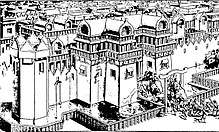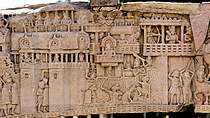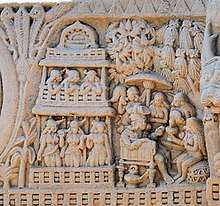Malla (Ancient India)
| Malla Mahajanapadas | |
|---|---|
| c. 700 BCE–c. 300 BCE | |
.png) Malla and other Mahajanapadas in the Post Vedic period. | |
| Capital | Kusavati (modern Kasia near Gorakhpur) and Pava (modern Fazilnagar) |
| Common languages | Sanskrit |
| Religion |
Hinduism Buddhism Jainism |
| Government | Republic |
| Raja | |
| Historical era | Bronze Age, Iron Age |
• Established | c. 700 BCE |
• Disestablished | c. 300 BCE |
| Today part of |
|
Malla was an ancient Indian republic (Gaṇa sangha) that constituted one of the solasa (sixteen) Mahajanapadas (great kingdoms) of ancient India. The republic is notable for being the chosen death place of Mahavira and Gautama Buddha.
History


Malla was one of the solasa (16) mahajanapadas of ancient India mentioned in the Anguttara Nikaya. It was named after the ruling clan of the same name. The Mahabharata (VI.9.34) mentions the territory as the Mallarashtra (Malla state). The Malla mahajanapada was situated north of Magadha. It was a small mahajanapada. The mahajanapada was divided into two main parts and the river Kakuttha (present day Kuku) was probably the dividing line. The capital of these two parts were Kusavati (modern Kasia near Gorakhpur) and Pava, modern Fazilnagar, 12 miles from Kasia.[1]
War over the Buddha's relics


Kusinara and Pava are very important in the history of Buddhism since Buddha took his last meal and was taken ill at Pava and went to his Mahaparinirvaṇa at Kusinara. After his death, the Mallas wanted to keep the ashes, but the other kingdoms also wanting their part went to war and besieged the city of Kushinagar. Finally, an agreement was reached, and the Buddha's cremation relics were divided among 8 royal families and his disciples; centuries later they would be enshrined by King Ashoka into 84,000 stupas.[2][3] A famous view in Sanchi shows the siege of Kushinagar, giving a view of the city which has been relied on for the understanding of ancient Indian constructions.
The Mallas were a powerful clan of eastern India[4] at the time of Gautama Buddha and they are frequently mentioned in Buddhist and Jaina works. The Mahabharata (II.30.3) mentions that the second Pandava Bhima is said to have conquered the chief of the Mallas in course of his expedition to eastern India. The Mahabharata (VI.9.46) mentions Mallas along with the Angas, Vangas, and Kalingas as eastern tribes.[4] The Mallas were republican people with their dominion consisting of nine territories (Kalpa Sutra; Nirayavali Sutra), one of each of the nine confederated clans.
The Mallas, like the Licchavis, are mentioned by Manusmriti as Vratya Kshatriyas.[5] They are called Vasishthas (Vasetthas) in the Mahapparnibbana Suttanta. The Mallas were a brave and warlike people. Jainism and Buddhism found many followers among the Mallas. The Mallas originally had a monarchical form of government but later they switched to Gana (republic or non-monarchial) of which the members called themselves rajas. The Gana were taking decisions from their Santhagara. The Mallas appeared to have formed alliance with Lichchhavis for self-defense. They however, lost their independence not long after Buddha’s death and their dominions were annexed to the Magadhan empire.
The two main towns of the Malla mahajanapada were Pava, where the Jain founder Mahavira died and Kusinara, where Buddha went to his Mahaparinirvaṇa. The Cullavagga of the Vinaya Pitaka mentions another town named Anupiya. A fourth town called Uruvelakappa is mentioned in the Anguttara Nikaya.[4] The fifth town was named as "Bhoganagara".

See also
References
- ↑ Raychaudhuri, Hemchandra (1972) Political History of Ancient India, University of Calcutta, Calcutta, pp. 85, 113
- ↑ Lopez Jr., Donald S. "The Buddha's relics". Encyclopædia Britannica.
- ↑ Strong 2007, pp. 136–37.
- 1 2 3 Law, B.C. (1973). Tribes in Ancient India, Poona: Bhandarkar Oriental Research Institute, pp.257-62
- ↑ Buddhism, Diplomacy, and Trade: The Realignment of Sino-Indian Relations, 600-1400 By Tansen Sen
- ↑ Asiatic Mythology by J. Hackin p.83ff
Sources
- Sankrityayan, Rahul. "Buddhacharya"- Life and Teachings of the Buddha (in Hindi). Gautam Book Centre. ISBN 9789380292175.
- Gorakhpur Janpad aur Uski Kshatriya Jatiyon Ka Itihaas By Dr. Rajbali Pandey, pp. 291–292
- Kshatriya Rajvansh by Dr. Raghunath Chand Kaushik
- Bhagwan Buddh ke Samkalin Anuyayi tatha Buddha Kendra By Tripatkacharya, Mahopadhyaya Bikshu Buddhamitra, pp. 274–283.